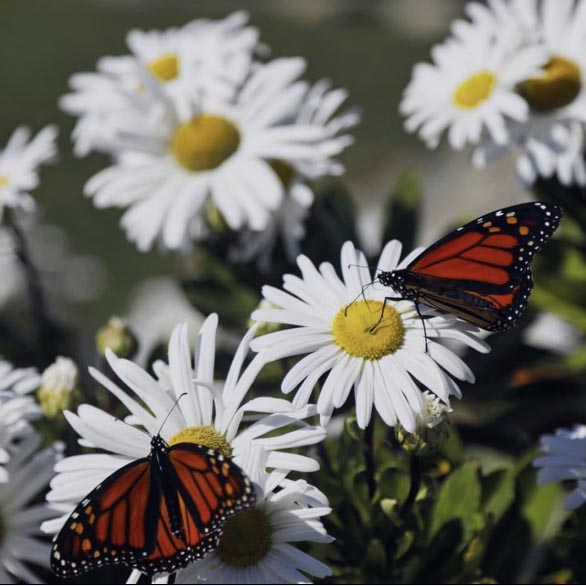
Monarch butterflies near the Pemaquid Point Lighthouse. (Photo courtesy Thomas W.P. Slatin)
Last fall, when photographer Thomas Slatin and his fiancee, Angie Conklin, visited the Midcoast region of Maine, they and other tourists encountered what the lighthouse keeper referred to as an “uncharacteristically late in the season” sighting of monarch butterflies, during a time frame which approached mid-October.
“We were waiting to climb to the top of the Pemaquid Point Lighthouse and the gentleman in charge of the lighthouse, who saw my camera, said, paraphrasing, you may want to step outside and take some photographs of the beautiful monarchs. So we did,” Slatin said.
Slatin, Conklin, and many other visitors at the lighthouse pulled out their cameras or smartphones and began to document this stunning sighting of the monarchs, where the monarchs enjoyed an area dense with wildflowers just outside of the lighthouse.
“We were all dumbfounded in the best of ways. Dozens and dozens of the monarchs were enjoying a sunny, bright fall day, seeking the nourishment of the nectar and the abundant supply of wildflowers still in bloom,” said Slatin. The monarch butterflies were most likely preparing for their migration to Mexico, where thousands will gather together on the Oyamel fir trees, where they will remain until approximately March.
Maine is along the northern edge of the monarch’s migration to and from Mexico.
Simply put, there are four native species of milkweed in Maine, and the monarchs need to have milkweed native to the region in which it is planted in order to sustain and thrive. It is important that residents in Maine, for example, who want to help the monarch butterflies plant native milkweed. The more native milkweed plants one has, the more monarch butterflies one can host.
Planting wildflowers also helps the monarch to thrive. This is crucial, according to environmentalists who have been captivated by observing the life cycle and the migration of the monarchs.
When the monarch butterfly lays the tiniest of eggs beneath a milkweed leaf, as the eggs hatch and the caterpillars emerge, the foliage from the milkweed leaf is the source of food. The caterpillars feed on the foliage of the milkweed leaf until they are ready to form their chrysalis and prepare for their metamorphosis to become a butterfly.
Once monarch caterpillars have emerged into monarch butterflies, they will also enjoy the nectar from a wide variety of wildflowers that bloom in the summer and the fall. Wildflowers are important to include in flower gardens due to the fact that, typically, by the onset of September the milkweed flowers are no longer blooming. The blooming and beautiful wildflowers planted outside of Pemaquid Point Lighthouse in Bristol, as photographed by visiting photographer Slatin and many others, are actually vital to the monarchs who prepare for migration.
Adding wildlowers to one’s garden allows for a diversity in the nectar available to the monarch butterflies too. According to an environmentalist at the University of Maine, people should be sure not to plant the wrong kind of milkweed, that which is not native to the region. In the the case of non-native milkweed, the monarch could be infected with parasites if they ingest it.
The loss of native milkweed plants in various regions of the United States continues to be an issue, yet it is a fixable issue. Plant native milkweed and a wide variety of wildflowers. This helps the monarch butterfly to thrive.
Monarchs truly have a coevolutionary interdependent relationship with native plants in the milkweed family. Creating a landscape in Maine that offers support and sustenance to the monarch caterpillars, who go through metamorphosis to become monarch butterflies, as well as for pollinating insects, is truly vital.
It should be mentioned that what is referred to as the “butterfly flower” is not good for monarch butterflies, a good point to remember for those building their landscapes and flower gardens to depict the beauty in nature that the monarch butterflies most definitely convey through their existence.
Slatin and Conklin plan to visit the Midcoast region of Maine again in the fall of next year, and many years thereafter. They hope to always have beautiful monarch sightings time and time again.



